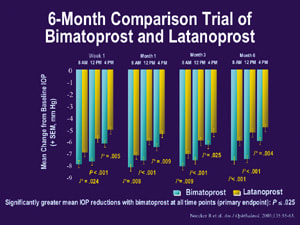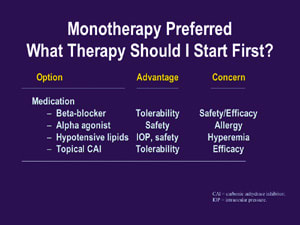Choosing Successful Glaucoma Therapy
Published studies reveal that some topical glaucoma
medications lower IOP more effectively than others.
Here's how you can use this information to prevent disease progression.
By Thomas E. Bournias, M.D., Chicago
Evidence-based treatment plans enhance patient care by combining the best evidence from current research with personal experience and clinical expertise. When clinically applying current research, it's important to understand the hypothesis being tested, specifically, what question researchers are trying to answer. Most studies clearly present results and validity, but few answer the most important question: Will these data help us care for our patients?1
|
|
|
|
|
|

|
|

|
|

|
|

|
|

|
Interpreting data
Papers are good sources for finding out whether a therapy works, but a poor way to test whether the recommended course of action will work in your practice. Your patients probably aren't anything like the "average" patients who participated in a particular study. You need to bring your own experience to every treatment decision and consider each patient individually. Does the patient have significant optic nerve changes or visual field loss? Is he subject to treatment-determining factors such as age or race?
For example, an older patient with slowly progressing glaucoma may require less potent treatment than a younger patient with rapidly progressing disease. Evidence-based medicine lets you meet the needs of individual patients.
Starting With Hypotensive Lipids
A medical regimen of beta-blockers, alpha agonists, hypotensive lipids or topical carbonic anhydrase inhibitors (CAIs) usually is the first treatment option for patients with glaucoma. These agents effectively lower IOP and are generally well-tolerated.
In recent years, hypotensive lipids, including bimatoprost (Lumigan), travoprost (Travatan) and latanoprost (Xalatan) have become the first-line treatment of choice for glaucoma. (See "Monotherapy Preferred: What Therapy Should I Start First?") A single drop of a hypotensive lipid at night can lower IOP by more than 35%. Moreover, these drugs are not associated with tachyphylaxis or systemic adverse effects.
Several studies in the United States and Europe compared the efficacy of bimatoprost, latanoprost and travoprost with that of timolol (Timoptic), a beta-blocker. All these agents provided greater IOP-lowering than timolol; by 2.1 mm Hg to 2.4 mm Hg for bimatoprost; 0.7 mm Hg to 1.2 mm Hg for latanoprost and 0.6 mm Hg to 1.4 mm Hg for travoprost.2 (See "Hypotensive Lipids: IOP Lowering vs. Timolol.")
A 3-month prospective, randomized trial performed by Parrish and colleagues3 showed that bimatoprost, latanoprost and travoprost similarly lower IOP. Latanoprost caused the least hyperemia of the three, but bimatoprost produced consistently lower IOPs. Bimatoprost also performed better later in the day, although this study didn't analyze time-related efficacy. (See "12-week Comparison Trial of Once-Daily Hypotensive Lipids.")
Noecker and colleagues4 conducted a 6-month study comparing bimatoprost with latanoprost. At all visits (week 1, month 1, month 3, month 6) and all time points (8 a.m., 12 p.m. and 4 p.m.), the decrease from baseline IOP was 1 mm Hg to 2 mm Hg greater with bimatoprost than latanoprost. All differences in IOP were statistically significant. (See "6-month Comparison Trial of Bimatoprost and Latanoprost.")
Patients taking bimatoprost also attained target pressures and pressure reductions more often than did patients taking latanoprost. At month 6, the mean percentage of patients achieving 15% IOP reduction was 87% for bimatoprost and 69% for latanoprost. A mean of 76.6% of patients achieved 20% IOP reduction with bimatoprost, compared with 58% of patients using latanoprost. Finally, the mean percentage of patients who achieved a 30% IOP reduction using bimatoprost was 49.6%; of those using latanoprost, 33.3% achieved this reduction.
These and other studies comparing the efficacy of bimatoprost and latanoprost36 showed mean IOP reduction was greater with bimatoprost at 29 of 30 time points examined. Mean IOP was never lower with latanoprost.
Based on these studies, most physicians recognize the superiority of hypotensive lipids for lowering IOP, particularly bimatoprost, which has consistently demonstrated greater efficacy.
Switching Monotherapy
If a patient fails to achieve sufficient IOP-lowering with one hypotensive lipid, can better results be achieved by switching to another hypotensive lipid? Gandolfi and Cimino7 randomized 15 nonresponders -- patients who failed to achieve a 20% IOP reduction with latanoprost -- to receive either latanoprost or bimatoprost for 30 days. After a 30-day washout, each patient was treated with the other medication to complete the crossover study design.
None of the latanoprost nonresponders enrolled in the study responded to latanoprost therapy. Thirteen patients, however, did respond to bimatoprost therapy. On average, patients treated with bimatoprost achieved a 6-mm Hg to 7-mm Hg IOP reduction. (See "IOP Lowering with Bimatoprost in Latanoprost Nonresponders.")
Safety Profiles and Side Effects
Noecker and colleagues4 found that 44.4% of patients treated with bimatoprost and 20.6% of patients treated with latanoprost developed hyperemia. Approximately 4.5% of patients discontinued bimatoprost secondary to adverse effects, including 2.3% for hyperemia. Approximately 3.7% of patients stopped using latanoprost because of adverse events, none of whom discontinued treatment for hyperemia. One patient in the latanoprost group developed uveitis, but there were no instances of cystoid macular edema.
Noecker and colleagues4 found that bimatoprost is associated with conjunctival hyperemia twice as often as with latanoprost; however, cases were usually characterized as "trace" or "mild." Hyperemia was not associated with inflammation, reduced patient compliance or anything else of clinical significance in either treatment group.
In a 2003 study by Abelson and colleagues,8 mean hyperemia scores for patients using bimatoprost were about 1.5 (on a scale of 1 to 7) after the first day of treatment. They declined steadily to about 0.5 on day 28, near the baseline value of 0.3. In general, about one-third of patients never develop hyperemia, one-third develop hyperemia initially but the condition resolves, and the remainder develop significant hyperemia. When patients experience adverse effects, such as hyperemia, we must decide if they're severe enough to stop treatment. Patients who achieve a significant IOP reduction may tolerate a certain degree of hyperemia and continue using the agent (often with eventual resolution of the hyperemia).
According to a 2002 survey of more than 4,200 patients by the Glaucoma Research Foundation, bimatoprost, latanoprost and travoprost all have similar rates for side effects, such as burning and stinging.9 (See "GRF Survey Results: Side Effects of Hypotensive Lipids.")
In the same survey, researchers asked patients whether they would rather use a hypotensive lipid that caused fewer side effects or one that lowered IOP most effectively.
The majority of respondents (92%) selected, "I want the eye drop that lowers eye pressures the most, even if it causes red eye for a few weeks." Only 8% selected, "I want an eye drop that doesn't cause red eye, even if it doesn't get my eye pressures as low." We should take these results into consideration when assessing the side effects of glaucoma medications. Patients and physicians may have different perceptions of what constitutes hyperemia or what is tolerable.
Choosing Adjunctive Therapy
If patients don't achieve lower IOPs with first-line hypotensive lipid therapy, you may need to reconsider your treatment plan. One option is to continue monotherapy with another lipid, but if the IOP remains dangerously high, you may need to move on to adjunctive therapy. Before adding new medications, however, you must consider factors such as systemic and ocular safety, tolerability and how the new agent will complement the primary medication's mechanism of action.
Adjunctive therapy also should meet pre-defined efficacy goals. Additional medications should decrease IOP by 15% or more to be worth the added cost, inconvenience and potential for increased side effects.
Common adjunctive agents include beta-blockers, alpha agonists and topical CAIs. Many physicians also consider laser trabeculoplasty an adjunctive medical option because it's a relatively noninvasive, benign procedure.
In 1999, Bucci and colleagues10 tested the efficacy of beta-blocker (timolol) and hypotensive lipid (latanoprost) adjunctive therapy compared with latanoprost monotherapy. Half the patients used timolol and latanoprost, lowering IOP only an additional 0.6 mm Hg more than latanoprost alone. The authors concluded that latanoprost monotherapy lowered IOP almost as effectively as timolol and latanoprost together (25% reduction and 28% reduction, respectively).
Research suggests that brimonidine (Alphagan), an alpha agonist that lowers IOP by decreasing aqueous production and increasing uveoscleral outflow, more effectively reduces IOP when used with latanoprost than does timolol/latanoprost adjunctive therapy. Walters and colleagues11 demonstrated more than 1 mm Hg additional IOP-lowering when brimonidine was used with a hypotensive lipid versus timolol. These findings are reinforced by Lee and Gornbein.12
A recent change in brimonidine formulation causes fewer side effects while preserving efficacy. In a 2002 study, patients taking brimonidine with Purite (Alphagan P) had fewer adverse events than those taking brimonidine preserved with benzalkonium chloride, including fewer allergies and other systemic effects.13 (See "Lower Incidence of Adverse Events with Brimonidine-Purite 0.15%, FDA Phase III.")
Laser trabeculoplasty usually isn't performed as primary therapy because, unlike hypotensive lipids, this procedure doesn't produce 25% to 35% IOP reductions. However, as an adjunctive agent, laser trabeculoplasty reduces IOP by 3-mm Hg to 5-mm Hg in about 75% of patients.
We also should consider race before starting any patient on adjunctive therapy. Treatment results for African-American patients may differ from those of white patients, who respond better to beta-blockers. Whether using bimatoprost, latanoprost or travoprost, African-Americans often benefit more with adjunctive therapy with alpha agonists, followed by topical CAIs and then beta-blockers. White patients should try alpha agonists or beta-blockers before moving on to topical CAIs.
Putting Results Into Practice
Published studies and clinical experience have shown that of the hypotensive lipids, bimatoprost is the most effective monotherapeutic agent for lowering IOP.
As we continue to investigate the merits of evidence-based medicine, we'll no doubt benefit from ongoing research. Every new study will help us determine what medications are best suited for treating different types of glaucoma and uncover more effective adjunctive therapies.
Dr. Bournias is the director of the Northwestern Ophthalmic Institute. He's assistant professor of clinical ophthalmology at Northwestern University, Feinberg School of Medicine.
References
1. Mant D. Can randomized trials inform clinical decisions about individual patients? Lancet. 1999;353:743746.
2. Cohen J. Bimatoprost, latanoprost, and travoprost: balancing efficacy against side effects. Presented at the American Glaucoma Society Annual Meeting; March 47, 2004; Sarasota, FL.
3. Parrish RK, Palmberg P, Sheu WP, XLT Study Group. A comparison of latanoprost, bimatoprost, and travoprost in patients with elevated intraocular pressure: A 12-week, randomized, masked-evaluator multicenter study. Am J Ophthalmol. 2003;135:688703.
4. Noecker RS, Dirks MS, Choplin NT, et al. A six-month randomized clinical trial comparing the intraocular pressure-lowering efficacy of bimatoprost and latanoprost in patients with ocular hypertension or glaucoma. Am J Ophthalmol. 2003;135:5563.
5. DuBiner H, Cooke D, Dirks M, et al. Efficacy and safety of bimatoprost in patients with elevated intraocular pressure: A 30-day comparison with latanoprost. Surv Ophthalmol. 2001;45(Suppl 4):S353S360.
6. Gandolfi S, Simmons ST, Sturm R, et al. Three-month comparison of bimatoprost and latanoprost in patients with glaucoma and ocular hypertension. Adv Ther. 2001;18:110121.
7. Gandolfi SA, Cimino L. Effect of bimatoprost on patients with primary open-angle glaucoma or ocular hypertension who are nonresponders to latanoprost. Ophthalmology. 2003;110:609614.
8. Abelson M, Mroz M, Rosner SA, et al. Multicenter, open-label evaluation of hyperemia associated with use of bimatoprost in adults with open-angle glaucoma or ocular hypertension. Adv Ther. 2003;20:113.
9. Glaucoma Research Foundation survey, 2002.
10. Bucci MG. Intraocular pressure-lowering effects of latanoprost monotherapy versus latanoprost or pilocarpine in combination with timolol: A randomized, observer-masked multicenter study in patients with open-angle glaucoma. Italian Latanoprost Study Group. J Glaucoma. 1999;8:2430.
11. Walters TR, Shapiro AM, Chapin MJ. A comparison of the efficacy, safety, and quality of life of brimonidine with latanoprost vs latanoprost with timolol. Invest Ophthalmol Vis Sci. 2000;41:2736.
12. Lee DA, Gornbein JA. Efficacy and safety of brimonidine as adjunctive therapy for patients with elevated intraocular pressure in a large, open-label community trial. J Glaucoma. 2001;10:220226.
13. Katz LJ. Twelve-month evaluation of brimonidine-purite versus brimonidine in patients with glaucoma or ocular hypertension. J Glaucoma. 2002;11:119126.










